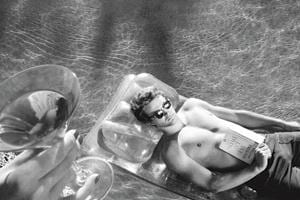In trying to define outsider “gay sensibility” in his imperishable book The Celluloid Closet, Vito Russo invokes the dulcet tones of James Dean. “Poor kid,” remarks Dean’s character, Jim, over the corpse of Plato (Sal Mineo) in Rebel Without a Cause, “he was always cold.”
James Dean. It’s a name that has become as iconic as Marilyn Monroe or Elvis Presley, a kind of shorthand for American culture in the 20th century. Dean, the quintessential outsider, is the subject of a new film, Joshua Tree, 1951: A Portrait of James Dean, that explores the early days of an indelible American – and indeed, gay – icon.
“One of the things, I think, that’s unique about our film,” explains its wunderkind writer/director Matthew Mishory on the phone from Los Angeles, “is that we don’t focus on the years of success; we focus on the years that brought him there.” Joshua Tree, 1951 — Mishory’s first feature — brings into focus the paradox of a young actor determined to be taken seriously as an artist who is simultaneously hungry for fame and glory.
The film is a blend of history, historiography and speculation. Rising star James Preston, the former face of Abercrombie & Fitch, plays Dean as an acting student at UCLA involved in a complex relationship with a beautiful male roommate in Santa Monica.
The film plays out as a dreamlike series of vignettes rendered in sumptuous high-contrast black and white, evoking the highly stylized glamour of old Hollywood. Its distinct chiaroscuro look owes as much to the old masters as to old Hollywood because, as Mishory explains, “The visual reference for me is Renaissance painting.”
The cinematography is not the only source of beauty in Joshua Tree, 1951. Mishory’s film is rife with male pulchritude, from the pansexual exploits of Dean himself to several scenes of clothing-optional pool parties thrown by a wealthy gay Hollywood power broker named Roger.
“Like many of the characters,” Mishory says, “[Roger] becomes a kind of composite.” Although based on several people, Mishory points to the radio director and producer Rogers Brackett as a main inspiration for Roger. “He mentored James Dean early in his career, and Dean actually lived with him for a while,” Mishory says. Brackett refused to kiss and tell about his time with James Dean, but ultimately, Mishory says, “he did acknowledge the sexual nature of their relationship.”
To recreate the gilt world of ’50s Hollywood, Mishory and his collaborators spent time with several people who bore witness to the closeted, but highly active, gay subculture of the period.
“I think the consistent theme was this notion that people — especially powerful people in Hollywood — lived exactly the way they wanted to live, at least behind closed doors . . . the sexual extravagance, the extravagance of wealth, the extravagance of lifestyle is something we can barely imagine today.”
Although the level of excess may have withered since Hollywood’s golden age, Mishory speculates that “in many ways, you could draw a straight line from 1951 to 2011, when we shot the film, and the pool scenes that we constructed for the movie could be taking place in the Hollywood Hills with contemporary characters and very, very few changes in clothing and dialogue.”
Joshua Tree, 1951 will have its world premiere in Seattle before playing Toronto’s Inside Out Festival.

 Why you can trust Xtra
Why you can trust Xtra


